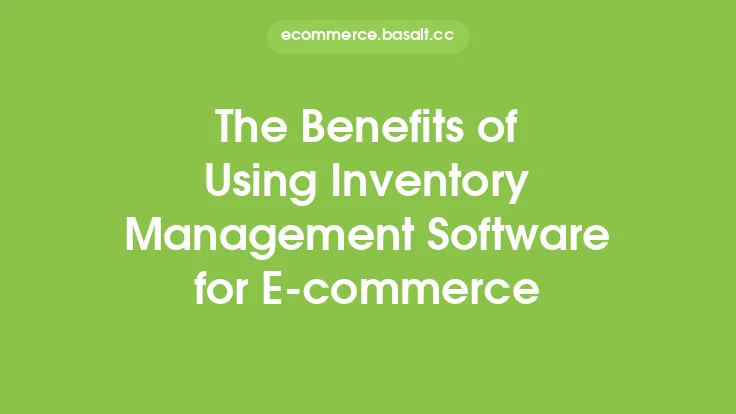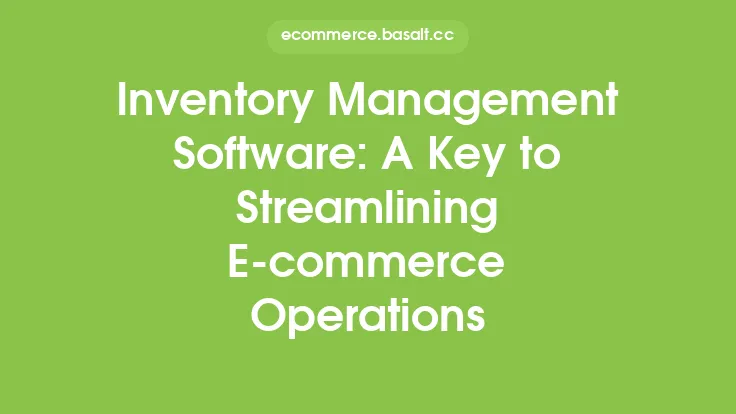In the world of e-commerce, effective inventory management is crucial for businesses to remain competitive and profitable. As online stores continue to grow and expand, managing inventory levels, tracking stock movements, and optimizing supply chains become increasingly complex tasks. This is where inventory management software comes into play, providing a comprehensive solution to streamline inventory-related operations and improve overall business efficiency. In this article, we will delve into the importance of inventory management software in e-commerce, exploring its benefits, key features, and how it can help businesses achieve their goals.
Introduction to Inventory Management Software
Inventory management software is a digital tool designed to help e-commerce businesses manage their inventory levels, track stock movements, and optimize supply chains. This software provides a centralized platform for businesses to monitor and control their inventory, from procurement to delivery. With inventory management software, businesses can automate many manual tasks, reduce errors, and gain real-time visibility into their inventory levels. This enables them to make informed decisions, respond quickly to changes in demand, and improve their overall operational efficiency.
Benefits of Inventory Management Software
The benefits of inventory management software are numerous and significant. One of the primary advantages is improved inventory accuracy, which helps businesses avoid stockouts, overstocking, and dead stock. By having accurate and up-to-date inventory levels, businesses can reduce the risk of lost sales, minimize waste, and optimize their inventory turnover. Inventory management software also enables businesses to streamline their supply chains, automate order fulfillment, and improve their shipping and delivery processes. Additionally, this software provides valuable insights and analytics, helping businesses to identify trends, optimize their pricing strategies, and make data-driven decisions.
Key Features of Inventory Management Software
Inventory management software typically includes a range of features that help businesses manage their inventory effectively. Some of the key features include inventory tracking, which enables businesses to monitor their stock levels in real-time; automated reporting, which provides valuable insights into inventory trends and patterns; and low-stock alerts, which notify businesses when their inventory levels are running low. Other features may include barcode scanning, which helps businesses to track their inventory quickly and accurately; multi-warehouse management, which enables businesses to manage inventory across multiple locations; and integration with e-commerce platforms, which streamlines order fulfillment and inventory updates.
How Inventory Management Software Improves E-commerce Operations
Inventory management software can significantly improve e-commerce operations in several ways. Firstly, it helps businesses to optimize their inventory levels, reducing the risk of stockouts and overstocking. This enables businesses to minimize waste, reduce costs, and improve their overall profitability. Secondly, inventory management software streamlines order fulfillment, automating many manual tasks and reducing the risk of errors. This helps businesses to improve their shipping and delivery processes, reducing the time it takes to get products to customers. Finally, inventory management software provides valuable insights and analytics, helping businesses to identify trends, optimize their pricing strategies, and make data-driven decisions.
The Role of Inventory Management Software in Supply Chain Optimization
Inventory management software plays a critical role in supply chain optimization, enabling businesses to streamline their supply chains and improve their overall operational efficiency. By providing real-time visibility into inventory levels, this software helps businesses to anticipate and respond to changes in demand, reducing the risk of stockouts and overstocking. Inventory management software also enables businesses to automate their order fulfillment processes, reducing the time it takes to get products to customers. Additionally, this software provides valuable insights into supply chain performance, helping businesses to identify areas for improvement and optimize their logistics and shipping processes.
Best Practices for Implementing Inventory Management Software
Implementing inventory management software requires careful planning and execution. One of the best practices is to define clear goals and objectives, identifying the key benefits and outcomes that the business wants to achieve. Businesses should also assess their current inventory management processes, identifying areas for improvement and opportunities for automation. Additionally, businesses should choose an inventory management software that is scalable, flexible, and easy to use, with a user-friendly interface and robust features. Finally, businesses should provide comprehensive training to their staff, ensuring that they have the skills and knowledge needed to use the software effectively.
Common Challenges and Limitations of Inventory Management Software
While inventory management software can provide significant benefits to e-commerce businesses, there are also common challenges and limitations that businesses should be aware of. One of the primary challenges is the initial setup and implementation, which can be time-consuming and require significant resources. Businesses may also experience integration issues, particularly if they have existing e-commerce platforms or supply chain systems. Additionally, inventory management software can be expensive, particularly for small or medium-sized businesses. Finally, businesses may experience data accuracy issues, particularly if they have poor data quality or inadequate training.
Future of Inventory Management Software
The future of inventory management software is exciting and rapidly evolving. One of the key trends is the increasing use of artificial intelligence and machine learning, which enables businesses to anticipate and respond to changes in demand, optimize their inventory levels, and improve their overall operational efficiency. Another trend is the growing importance of cloud-based inventory management software, which provides businesses with greater flexibility, scalability, and accessibility. Additionally, there is a increasing focus on mobile inventory management, which enables businesses to manage their inventory on-the-go, using mobile devices and apps. Finally, there is a growing emphasis on sustainability and social responsibility, with businesses seeking to reduce their environmental impact and improve their social and ethical practices.
Conclusion
In conclusion, inventory management software is a critical component of e-commerce operations, providing businesses with a comprehensive solution to manage their inventory levels, track stock movements, and optimize supply chains. By automating many manual tasks, reducing errors, and providing real-time visibility into inventory levels, this software enables businesses to improve their operational efficiency, reduce costs, and increase their profitability. As the e-commerce industry continues to evolve and grow, the importance of inventory management software will only continue to increase, providing businesses with a competitive edge and enabling them to achieve their goals.





